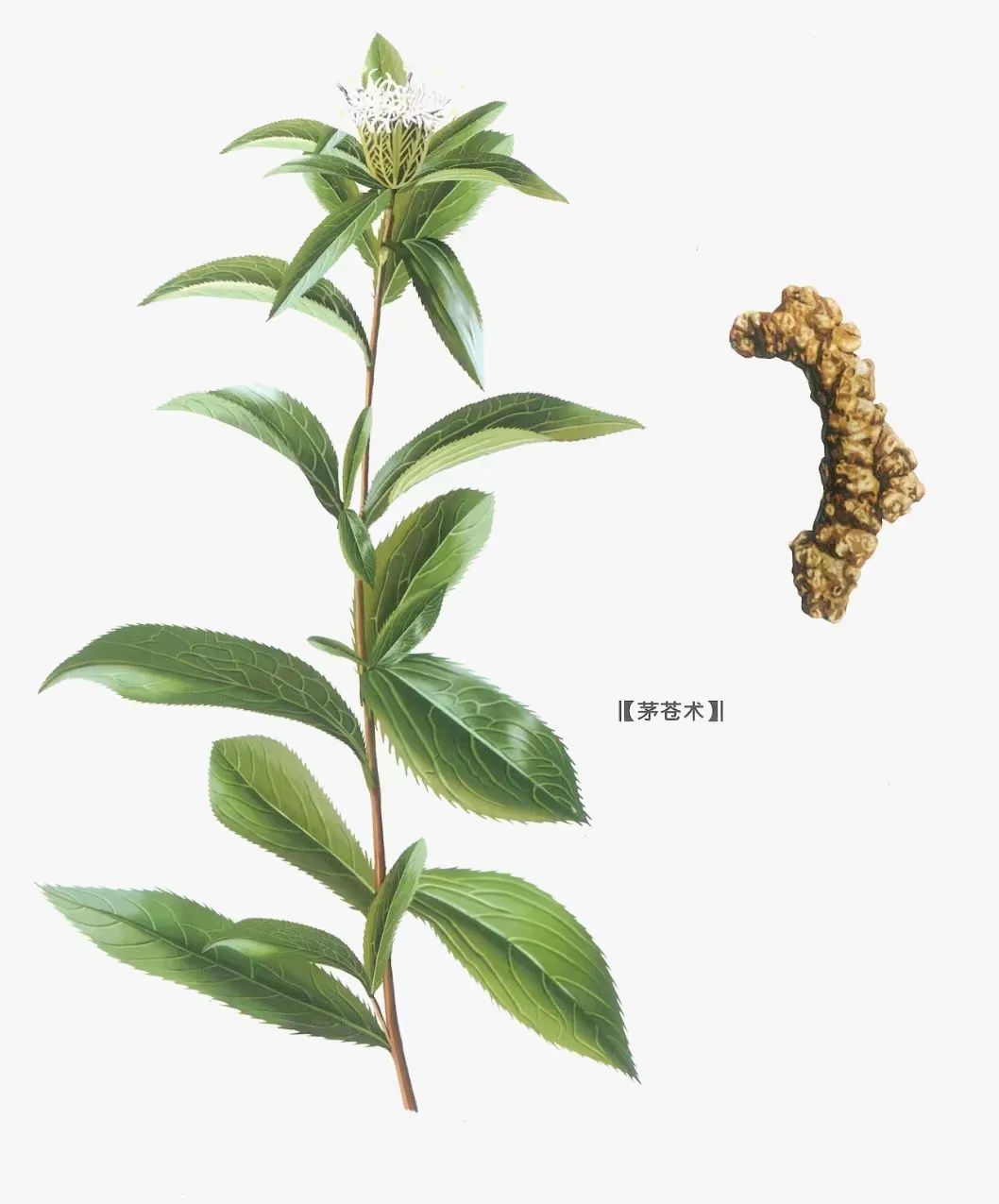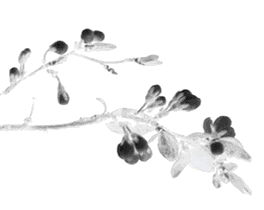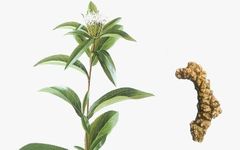
Click above to follow “Learn TCM“!

Cang Zhu (Atractylodes) is first recorded in the Shen Nong Ben Cao Jing (Shen Nong’s Classic of Materia Medica), which only mentions “Zhu” without distinguishing between Cang and Bai (White Atractylodes). Later, in Ben Cao Jing Ji Zhu by Tao Hongjing, a distinction is made between Chi (Red) and Bai Zhu. According to the description that “Chi Zhu has fine leaves without branches, and the roots are small, bitter, and oily,” the Chi Zhu described by Tao is indeed Cang Zhu. Subsequently, Zheng Lei Ben Cao began to use the name Cang Zhu. Li Shizhen stated: According to Liushu Benyi, the character “Zhu” in seal script resembles the shape of its roots, stems, and leaves. The root resembles old ginger, and the skin is of a grayish color, hence the name.

▲ The character “Zhu” in seal script
Cang Zhu is a plant of the Asteraceae family, and the part used is the rhizome of Cang Zhu. Ancient practitioners believed that the Cang Zhu from Maoshan in Jiangsu was the best, hence some prescriptions refer to it as Mao Zhu. When Cang Zhu is cut open, there are some red dot-like spots in the middle, called Zhu Sha (Cinnabar spots), which indicate its oil glands. The aromatic oil is contained within, making it a high-quality Mao Cang Zhu with more oil glands. If Cang Zhu is exposed for a while after being cut, a layer of white mold-like substance will appear on the surface, which is a normal phenomenon for high-quality Cang Zhu, hence some prescriptions refer to it as Shuang Cang Zhu or Shuang Zhu, indicating the selection of good quality Mao Cang Zhu.

Cang Zhu has a long history of medicinal use, listed as a superior herb in the Shen Nong Ben Cao Jing, stating: “It is primarily used for wind, cold, damp bi, and muscle spasms, and when taken for a long time, it lightens the body and prolongs life without hunger.” Since the Shen Nong Ben Cao Jing only mentions Zhu, the above effects apply to both Bai Zhu and Cang Zhu. The Ming Yi Bie Lu states: “It is used for headaches, eliminates phlegm and water, expels wind-water causing swelling, relieves fullness under the heart, and treats cholera with continuous vomiting and diarrhea, warms the stomach, and promotes appetite.” “It eliminates evil qi and alleviates disasters and rashes.” The Sheng Hui Fang states: “It treats night blindness.” The Jing Yan Fang states: “It treats internal and external eye obstructions.” The Zhen Zhu Nang states: “It can eliminate all swellings caused by dampness, and it can strengthen the stomach and calm the spleen.” Li Gao states: “It eliminates dampness, induces sweating, strengthens the stomach, and is a key herb for treating atrophy.” The Ben Cao Gang Mu states: “It treats damp phlegm retention, or when accompanied by blood stasis forming a mass, and for spleen dampness leading to turbid discharge, and for slippery bowel wind.” The Ben Cao Yan Yi Bu Yi states: “It disperses wind, benefits qi, and resolves all stagnation.” The records of various physicians throughout history reflect the main treatment scope of Cang Zhu. Later, Yao Pin Hua Yi added that it can expel “mountain miasma.” Yu Qu Yao Jie added “regulates sour ingestion and eliminates corruption,” and “clears turbid urination.” Ben Cao Qiu Yuan supplemented the treatment of “food stagnation and summer heat diarrhea, and spleen dampness leading to blood flow.” Therefore, since the Ming and Qing dynasties, materia medica has gradually summarized that this herb has the effects of drying dampness, strengthening the spleen, dispelling filth, transforming turbidity, expelling wind-dampness, releasing the exterior, and brightening the eyes.
Cang Zhu in the Shen Nong Ben Cao Jing
Properties: Pungent, bitter, warm. Channels: Spleen, Stomach, Liver.Effects: Dries dampness, strengthens the spleen, dispels wind and scatters cold.
Shen Nong Ben Cao Jing: Primarily used for wind, cold, damp bi, and muscle spasms. When taken for a long time, it lightens the body and prolongs life without hunger.
Ming Yi Bie Lu: Used for headaches, eliminates phlegm and water, expels wind-water causing swelling, relieves fullness under the heart, and treats cholera with continuous vomiting and diarrhea. Warms the stomach and promotes appetite.
Ben Cao Gang Mu: Treats damp phlegm retention… spleen dampness leading to turbid discharge, slippery bowel wind.
Usage Caution: This herb is bitter, warm, and drying, thusshould be avoided by those with yin deficiency and internal heat, or those with qi deficiency and excessive sweating. The first group of effects of Cang Zhu is drying dampness and strengthening the spleen. Drying dampness is an independent effect; why is Cang Zhu categorized under damp-transforming herbs, and its first effect is not described as transforming dampness but as drying dampness? In fact, Cang Zhu is both an aromatic damp-transforming herb and a bitter warm drying dampness herb. Its flavor includes bitterness, and its property is warm, making it a bitter warm drying dampness herb, which aligns with the theory that bitterness can dry according to the five flavors. It also has a strong aroma, which has the effect of transforming dampness and harmonizing, thus it is also an aromatic damp-transforming herb. Additionally, it has a distinct bitter taste, but in comparison between transforming dampness and drying dampness, the effect of drying dampness is stronger than that of transforming dampness. It is generally recognized as its strongest effect, hence Cang Zhu is considered both a damp-transforming herb and a drying dampness herb. Since it is generally believed that the drying dampness effect is superior to the transforming dampness effect, the primary effect of Cang Zhu is usually described as the stronger drying dampness effect.
So, what is the difference between drying dampness and transforming dampness?
Transforming dampness primarily treats the damp turbidity of the middle jiao, and most are aromatic herbs, commonly referred to as aromatic damp-transforming herbs; drying dampness refers to bitter herbs. Their effects are quite broad, both aim to eliminate damp turbidity and treat symptoms caused by damp turbidity, targeting damp evil as a therapeutic effect, so there is not a significant difference. Aromatic herbs are generally called transforming dampness, while bitter herbs are generally called drying dampness. If an aromatic herb has strong drying properties, it can also be referred to as drying dampness, and they do not need to be strictly separated.
In the previous discussion of exterior-releasing herbs, Bai Zhi also has the effect of drying dampness, but Bai Zhi has no bitterness; however, due to its strong drying properties, it is also referred to as drying dampness. Therefore, transforming dampness and drying dampness are sometimes used interchangeably and are not easily distinguished.
The first effect of Cang Zhu is drying dampness, treating damp obstruction in the middle jiao, and it is a key herb for treating damp obstruction in the middle jiao. Due to its strong warming and drying properties, it has a good ability to eliminate damp turbidity in the middle jiao, making it a key herb for treating damp obstruction in the middle jiao. The most representative formula is Ping Wei San (Calm the Stomach Powder), which is a fundamental formula in TCM for treating damp obstruction in the middle jiao. The main herb, or monarch herb, in this formula is Cang Zhu, thus establishing Cang Zhu as the first choice herb for treating damp obstruction in the middle jiao, or as a very important herb. When damp turbidity is severe and the symptoms are pronounced, Cang Zhu is an essential herb.
Ping Wei San consists of Cang Zhu, Hou Po (Magnolia Bark), Chen Pi (Dried Tangerine Peel), and Zhi Gan Cao (Honey-fried Licorice), with the function of drying dampness, regulating the spleen, and harmonizing the stomach, primarily treating damp stagnation in the spleen and stomach.
However, Cang Zhu does not have the function of moving qi, so it is often paired with qi-moving herbs. In Ping Wei San, there are Hou Po and Chen Pi, which are also drying dampness herbs, and they work synergistically in drying dampness. Additionally, they can compensate for Cang Zhu’s lack of qi-moving properties, making it more suitable for damp obstruction and qi stagnation. Cang Zhu is also a spleen-strengthening herb, which can directly strengthen the spleen and stomach. The strengthening of the spleen also facilitates the transformation of water and dampness, or the transformation of damp turbidity, thus enhancing Cang Zhu’s effect in treating damp obstruction in the middle jiao. Therefore, strengthening the spleen can also play a supportive role in drying dampness. However, as a spleen-strengthening herb, theoretically, it should correspond to the syndrome of spleen deficiency, but in the context of Cang Zhu’s spleen-strengthening properties, we do not find any text indicating treatment for spleen deficiency syndrome. Why is this the case? This is because we will later learn about another herb called Bai Zhu, which, during Zhang Zhongjing’s time, was not differentiated from Cang Zhu and was collectively referred to as Zhu. Later, they were separated into different herbs. Both Cang Zhu and Bai Zhu have spleen-strengthening effects, but Bai Zhu’s effect is stronger, thus it is used to treat deficiency syndromes. For spleen deficiency, we generally use Bai Zhu, and there is no need to use Cang Zhu. Cang Zhu is primarily used for damp turbidity obstruction, which in fact diminishes the application of spleen-strengthening. Ancient practitioners also used Cang Zhu to treat spleen deficiency syndrome. If we encounter a case with both spleen deficiency and damp turbidity in clinical practice, we can certainly use Cang Zhu, so it is just that it is not emphasized compared to Bai Zhu. As a bitter warm drying dampness herb, besides treating damp obstruction in the middle jiao, it can also be used for other damp turbidity conditions, such as phlegm retention and edema. Another effect is expelling wind-dampness. Cang Zhu, as a wind-dampness expelling herb, does not have the effect of relaxing tendons and activating collaterals or strengthening bones, but it excels at eliminating dampness. Therefore, clinically, Cang Zhu is often used for damp bi, particularly suitable for damp bi among wind-damp diseases, applicable for both cold-damp and damp-heat syndromes, but most suitable for cold bi, while hot bi should be combined with herbs that clear heat and dry dampness, such as Huang Bai (Phellodendron). Cang Zhu can also brighten the eyes. In fact, it treats night blindness, which was historically referred to as “sparrow eye.” Nowadays, night blindness is rarely seen clinically, as it was more common in the past due to a lack of animal food and long periods without fresh vegetables, leading to vitamin A deficiency, which is no longer significant today.
Cang Zhu is also a spleen-strengthening herb, which can directly strengthen the spleen and stomach. The strengthening of the spleen also facilitates the transformation of water and dampness, or the transformation of damp turbidity, thus enhancing Cang Zhu’s effect in treating damp obstruction in the middle jiao. Therefore, strengthening the spleen can also play a supportive role in drying dampness. However, as a spleen-strengthening herb, theoretically, it should correspond to the syndrome of spleen deficiency, but in the context of Cang Zhu’s spleen-strengthening properties, we do not find any text indicating treatment for spleen deficiency syndrome. Why is this the case? This is because we will later learn about another herb called Bai Zhu, which, during Zhang Zhongjing’s time, was not differentiated from Cang Zhu and was collectively referred to as Zhu. Later, they were separated into different herbs. Both Cang Zhu and Bai Zhu have spleen-strengthening effects, but Bai Zhu’s effect is stronger, thus it is used to treat deficiency syndromes. For spleen deficiency, we generally use Bai Zhu, and there is no need to use Cang Zhu. Cang Zhu is primarily used for damp turbidity obstruction, which in fact diminishes the application of spleen-strengthening. Ancient practitioners also used Cang Zhu to treat spleen deficiency syndrome. If we encounter a case with both spleen deficiency and damp turbidity in clinical practice, we can certainly use Cang Zhu, so it is just that it is not emphasized compared to Bai Zhu. As a bitter warm drying dampness herb, besides treating damp obstruction in the middle jiao, it can also be used for other damp turbidity conditions, such as phlegm retention and edema. Another effect is expelling wind-dampness. Cang Zhu, as a wind-dampness expelling herb, does not have the effect of relaxing tendons and activating collaterals or strengthening bones, but it excels at eliminating dampness. Therefore, clinically, Cang Zhu is often used for damp bi, particularly suitable for damp bi among wind-damp diseases, applicable for both cold-damp and damp-heat syndromes, but most suitable for cold bi, while hot bi should be combined with herbs that clear heat and dry dampness, such as Huang Bai (Phellodendron). Cang Zhu can also brighten the eyes. In fact, it treats night blindness, which was historically referred to as “sparrow eye.” Nowadays, night blindness is rarely seen clinically, as it was more common in the past due to a lack of animal food and long periods without fresh vegetables, leading to vitamin A deficiency, which is no longer significant today.

In the next issue, we will introduce Hou Po. If you have any questions, feel free to leave a message for discussion!
This article is sourced from: Lectures by Famous TCM Experts – Zhang Tingmo’s Clinical Materia Medica Lectures, Chinese Clinical Materia Medica. Images are sourced from the internet, and copyright belongs to the original authors!



Long press the QR code to recognize and follow us
Learn TCM
Let’s work hard together!

